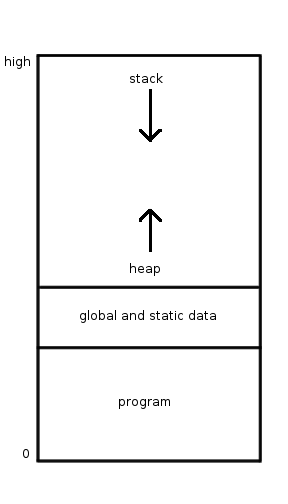|
Imperative Programming
In computer science, imperative programming is a programming paradigm of software that uses statements that change a program's state. In much the same way that the imperative mood in natural languages expresses commands, an imperative program consists of commands for the computer to perform. Imperative programming focuses on describing ''how'' a program operates step by step, rather than on high-level descriptions of its expected results. The term is often used in contrast to declarative programming, which focuses on ''what'' the program should accomplish without specifying all the details of ''how'' the program should achieve the result. Imperative and procedural programming Procedural programming is a type of imperative programming in which the program is built from one or more procedures (also termed subroutines or functions). The terms are often used as synonyms, but the use of procedures has a dramatic effect on how imperative programs appear and how they are constructed ... [...More Info...] [...Related Items...] OR: [Wikipedia] [Google] [Baidu] |
Computer Science
Computer science is the study of computation, automation, and information. Computer science spans theoretical disciplines (such as algorithms, theory of computation, information theory, and automation) to practical disciplines (including the design and implementation of hardware and software). Computer science is generally considered an area of academic research and distinct from computer programming. Algorithms and data structures are central to computer science. The theory of computation concerns abstract models of computation and general classes of problems that can be solved using them. The fields of cryptography and computer security involve studying the means for secure communication and for preventing security vulnerabilities. Computer graphics and computational geometry address the generation of images. Programming language theory considers different ways to describe computational processes, and database theory concerns the management of repositories ... [...More Info...] [...Related Items...] OR: [Wikipedia] [Google] [Baidu] |
Reconfigurable Computing
Reconfigurable computing is a computer architecture combining some of the flexibility of software with the high performance of hardware by processing with very flexible high speed computing fabrics like FPGA, field-programmable gate arrays (FPGAs). The principal difference when compared to using ordinary microprocessors is the ability to make substantial changes to the datapath itself in addition to the control flow. On the other hand, the main difference from custom hardware, i.e. application-specific integrated circuits (ASICs) is the possibility to adapt the hardware during runtime by "loading" a new circuit on the reconfigurable fabric. History The concept of reconfigurable computing has existed since the 1960s, when Gerald Estrin's paper proposed the concept of a computer made of a standard processor and an array of "reconfigurable" hardware. The main processor would control the behavior of the reconfigurable hardware. The latter would then be tailored to perform a specific ... [...More Info...] [...Related Items...] OR: [Wikipedia] [Google] [Baidu] |
Do While Loop
In most computer programming languages a do while loop is a control flow statement that executes a block of code and then either repeats the block or exits the loop depending on a given boolean condition. The ''do while'' construct consists of a process symbol and a condition. First the code within the block is executed. Then the condition is evaluated. If the condition is true the code within the block is executed again. This repeats until the condition becomes false. Do while loops check the condition after the block of code is executed. This control structure can be known as a post-test loop. This means the do-while loop is an exit-condition loop. However a while loop will test the condition before the code within the block is executed. This means that the code is always executed first and then the expression or test condition is evaluated. This process is repeated as long as the expression evaluates to true. If the expression is false the loop terminates. A while loop se ... [...More Info...] [...Related Items...] OR: [Wikipedia] [Google] [Baidu] |
While Loop
In most computer programming languages, a while loop is a control flow statement that allows code to be executed repeatedly based on a given Boolean condition. The ''while'' loop can be thought of as a repeating if statement. Overview The ''while'' construct consists of a block of code and a condition/expression. The condition/expression is evaluated, and if the condition/expression is ''true'', the code within all of their following in the block is executed. This repeats until the condition/expression becomes false. Because the ''while'' loop checks the condition/expression before the block is executed, the control structure is often also known as a pre-test loop. Compare this with the ''do while'' loop, which tests the condition/expression ''after'' the loop has executed. For example, in the C programming language (as well as Java, C#, Objective-C, and C++, which use the same syntax in this case), the code fragment int x = 0; while (x 0 loop Factorial := Fac ... [...More Info...] [...Related Items...] OR: [Wikipedia] [Google] [Baidu] |
Function (mathematics)
In mathematics, a function from a set to a set assigns to each element of exactly one element of .; the words map, mapping, transformation, correspondence, and operator are often used synonymously. The set is called the domain of the function and the set is called the codomain of the function.Codomain ''Encyclopedia of Mathematics'Codomain. ''Encyclopedia of Mathematics''/ref> The earliest known approach to the notion of function can be traced back to works of Persian mathematicians Al-Biruni and Sharaf al-Din al-Tusi. Functions were originally the idealization of how a varying quantity depends on another quantity. For example, the position of a planet is a ''function'' of time. Historically, the concept was elaborated with the infinitesimal calculus at the end of the 17th century, and, until the 19th century, the functions that were considered were differentiable (that is, they had a high degree of regularity). The concept of a function was formalized at the end of ... [...More Info...] [...Related Items...] OR: [Wikipedia] [Google] [Baidu] |
Arithmetic
Arithmetic () is an elementary part of mathematics that consists of the study of the properties of the traditional operations on numbers—addition, subtraction, multiplication, division, exponentiation, and extraction of roots. In the 19th century, Italian mathematician Giuseppe Peano formalized arithmetic with his Peano axioms, which are highly important to the field of mathematical logic today. History The prehistory of arithmetic is limited to a small number of artifacts, which may indicate the conception of addition and subtraction, the best-known being the Ishango bone from central Africa, dating from somewhere between 20,000 and 18,000 BC, although its interpretation is disputed. The earliest written records indicate the Egyptians and Babylonians used all the elementary arithmetic operations: addition, subtraction, multiplication, and division, as early as 2000 BC. These artifacts do not always reveal the specific process used for solving problems, b ... [...More Info...] [...Related Items...] OR: [Wikipedia] [Google] [Baidu] |
Expression (programming)
In computer science, an expression is a syntactic entity in a programming language that may be evaluated to determine its value. It is a combination of one or more constants, variables, functions, and operators that the programming language interprets (according to its particular rules of precedence and of association) and computes to produce ("to return", in a stateful environment) another value. This process, for mathematical expressions, is called ''evaluation''. In simple settings, the resulting value is usually one of various primitive types, such as numerical, string, boolean, complex data type or other types. Expression is often contrasted with statement—a syntactic entity that has no value (an instruction). Examples For example, 2 + 3 is both an arithmetic and programming expression, which evaluates to 5. A variable is an expression because it denotes a value in memory, so y + 6 is also an expression. An example of a relational expression is 4 ≠ 4, which eva ... [...More Info...] [...Related Items...] OR: [Wikipedia] [Google] [Baidu] |
Evaluation (other)
Evaluation is the process of judging something or someone based on a set of standards. Evaluation may also refer to: Measurement or appraisal * Education: ** Competency evaluation (language), a means for teachers to determine the ability of their students ** Narrative evaluation, a form of performance measurement and feedback which can be used instead of grading * Competency evaluation (law), an assessment of the ability of a defendant to understand and rationally participate in a court process * Formation evaluation in petroleum exploration, used to determine the commercial-viability of a potential oil or gas field * Human resources: ** Evaluation (workplace), a tool employers use to review the performance of an employee ** Performance evaluation, a method by which the job performance of an employee is evaluate ** Evaluation (basketball), a statistical formula used to rank basketball players in some European leagues ** Evaluation camp, a program in which athletes from Canadia ... [...More Info...] [...Related Items...] OR: [Wikipedia] [Google] [Baidu] |
Destructive Assignment
Destruction may refer to: Concepts * Destruktion, a term from the philosophy of Martin Heidegger * Destructive narcissism, a pathological form of narcissism * Self-destructive behaviour, a widely used phrase that ''conceptualises'' certain kinds of destructive acts as belonging to the self * Slighting, the deliberate destruction of a building * Final destruction ( End of the World) Comics and gaming * Destruction (DC Comics), one of the Endless in Neil Gaiman's comic book series ''The Sandman'' * Destructoid, a video-game blog Music * Destruction (band), a German thrash metal band * '' ''Destruction'' (EP)'', a 1994 EP by Destruction * "Destruction" (song), a 2015 song by Joywave * "Destruction", a 1984 song by Loverboy featured in Giorgio Moroder’s restoration of the film ''Metropolis'' * "The Destruction", a song from the 1988 musical '' Carrie'' Television and film * "Destruction" (UFO), a 1970 episode of ''UFO'' * ''Destruction'' (film), a 1915 film starring Theda B ... [...More Info...] [...Related Items...] OR: [Wikipedia] [Google] [Baidu] |
Computer Program
A computer program is a sequence or set of instructions in a programming language for a computer to execute. Computer programs are one component of software, which also includes documentation and other intangible components. A computer program in its human-readable form is called source code. Source code needs another computer program to execute because computers can only execute their native machine instructions. Therefore, source code may be translated to machine instructions using the language's compiler. (Assembly language programs are translated using an assembler.) The resulting file is called an executable. Alternatively, source code may execute within the language's interpreter. If the executable is requested for execution, then the operating system loads it into memory and starts a process. The central processing unit will soon switch to this process so it can fetch, decode, and then execute each machine instruction. If the source code is requested for e ... [...More Info...] [...Related Items...] OR: [Wikipedia] [Google] [Baidu] |
Checklist
A checklist is a type of job aid used in repetitive tasks to reduce failure by compensating for potential limits of human memory and attention. It helps to ensure consistency and completeness in carrying out a task. A basic example is the "to do list". A more advanced checklist would be a schedule, which lays out tasks to be done according to time of day or other factors. A primary task in checklist is documentation of the task and auditing against the documentation. Use of a written checklist can reduce any tendency to avoid, omit or neglect important steps in any task. Applications *aid in aviation safety to ensure that critical items are not overlooked. Example: Pre-flight checklists * Used in quality assurance of software engineering, to check process compliance, code standardization and error prevention, and others. * Often used in industry in operations procedures * In civil litigation to deal with the complexity of discovery and motions practice. An example is the o ... [...More Info...] [...Related Items...] OR: [Wikipedia] [Google] [Baidu] |
Recipe
A recipe is a set of instructions that describes how to prepare or make something, especially a dish of prepared food. A sub-recipe or subrecipe is a recipe for an ingredient that will be called for in the instructions for the main recipe. History Early examples The earliest known written recipes date to 1730 BC and were recorded on cuneiform tablets found in Mesopotamia. Other early written recipes date from approximately 1600 BC and come from an Akkadian tablet from southern Babylonia. There are also works in ancient Egyptian hieroglyphs depicting the preparation of food. Many ancient Greek recipes are known. Mithaecus's cookbook was an early one, but most of it has been lost; Athenaeus quotes one short recipe in his ''Deipnosophistae''. Athenaeus mentions many other cookbooks, all of them lost.Andrew Dalby, ''Food in the Ancient World from A to Z'', 2003. p. 97-98. Roman recipes are known starting in the 2nd century BCE with Cato the Elder's '' De Agri Cultura''. Many ... [...More Info...] [...Related Items...] OR: [Wikipedia] [Google] [Baidu] |






